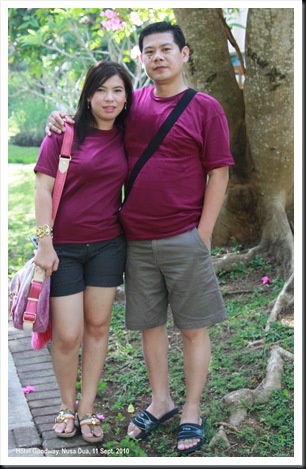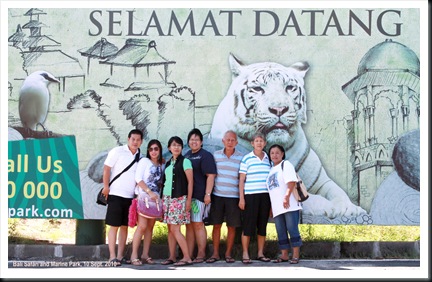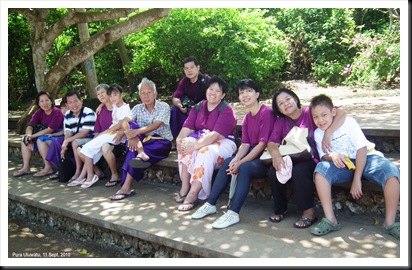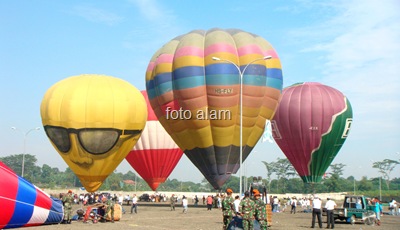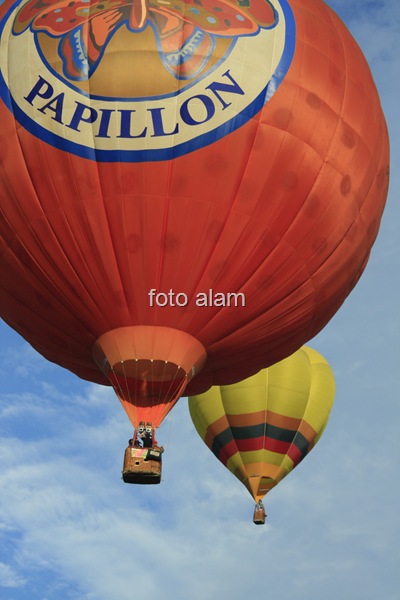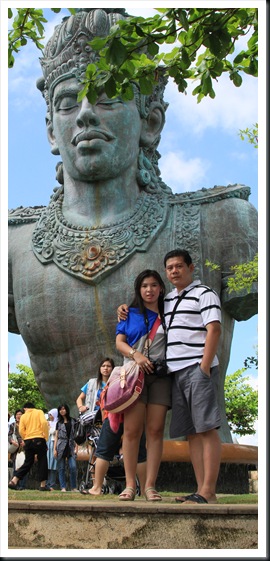 All pictures were taken with Canon EOS 7D + 24 – 105 mm f4.
All pictures were taken with Canon EOS 7D + 24 – 105 mm f4.
Friday, December 3, 2010
Lebaran Holiday 2010
This year Lebaran Holiday, we went to Bali. We visited Tanah Lot, Kuta Beach, Bali Safari and Marine Park, Pura Uluwatu, Garuda Wishnu Kencana. These are some of pictures taken while we were at Bali. Most of the pictures were taken by Canon EOS 7D + 24 – 105 mm f4. Only the last picture was taken by Fuji HS 10.
Read More...Wednesday, October 6, 2010
Top 10 New Camera Rumours For 2010
New and updated: we name the DSLRs, digital compacts and hybrid cameras that could be released before Christmas 2010
Here at PhotoRadar, we like to deal with fact rather than rumour. But we hope you'll indulge us as we get stuck into a spot of crystal ball gazing. What does 2010 hold in the way of new camera launches? You're about to hear our predictions...
1) 24-megapixel Nikon D700X
Rumours of a higher resolution version of the Nikon D700 were circulating as early as February 2009, and Nikon certainly needs to act quickly to keep up with the Canon EOS 5D MkII. The D700’s 12-megapixel sensor may be great at high ISOs, but the difference in resolution compared to the 21-megapixel EOS 5D MkII is painful. At the top end of the range, Nikon’s split its original D3 into a high-resolution model (D3X) and high-speed version (D3S). Logic suggests the venerable D700 is now ripe for the same treatment. Some sources suggest the D700 won’t get the same 24-megapixel sensor as the D3X in case it undermines its sales, guessing at 18MP or so instead, but Nikon didn’t worry about that when it launched the D700 alongside the D3, so why would it worry now?
Nikon D700X rumour update May 2010: Still no news from Nikon on this one, but there’s increased promotional activity in the UK, which is the usual precursor to a new model. Anyone buying a Nikon D700 between May 1st and June 30th 2010 can claim a free MB-D10 battery grip with a list price of £340. But what if we don’t get a Nikon D700X after all? What if we just get a Nikon D700S with a bit more speed and a higher ISO? Ho hum.
2) APS-C format Canon PowerShot G12
Canon showed with the PowerShot G11 that it wasn’t afraid to step back from the brink in the megapixel war, and the G11’s improved high ISO performance and excellent definition prove what everyone’s been saying all along – that you can’t increase megapixels without increasing the sensor size. And it could be that the G11 is only an interim measure for Canon and a stepping stone towards a much more radical camera, and that an APS-C format PowerShot is on the way. That’s not such a wild idea. Olympus and Panasonic have shown the level of interest which exists in larger-format compacts, and Samsung’s been bouncing around the NX concept camera for a while now. We think it’s not a question of if, but when.
Canon PowerShot G12 rumour update May 2010: There’s no sign of a big-sensor PowerShot G11 replacement just yet, and both Samsung and Sony are now shipping APS-C compacts. But an April Fool’s prank re-posted on a number of well-known websites put forward a barmy but actually rather tantalising alternative. Why not releaes a Canon full-frame compact hybrid? Everyone else is using APS-C sensors, so this might be a chance for Canon to seize the high ground again. Shame it’s not true...
3) Canon EOS 1Ds Mk IV
Once, the position of Canon’s EOS 1Ds was unassailable. Now it’s under threat both from rivals (Nikon D3X, Sony Alpha a900) and its own stablemate the EOS 5D MkII which, let’s not forget, has the same resolution as the 1Ds and an HD movie mode. A new version of the 1Ds is long overdue and some sources are suggesting it may have a radical new square 36 x 36mm sensor. This would retain compatibility with Canon’s EF lenses but offer a larger image area and the advantages of classic square medium format cameras (flexibility in cropping, no need to rotate the camera for different orientations). If Canon took this bold step it would be a showstopper, but at the very least we should expect an increase in resolution and a full HD movie mode.
EOS 1Ds Mk IV rumour update May 2010: Nothing to report here, alas, despite all the talk of square sensors (thanks to keithgg for the point about sensor sizes in the comments below, by the way, and the more likely 30mm maximum). It’s all guesswork right now, revolving around DIGIC V processing, huge resolution hikes and whopping frame rates. One thing’s for sure – Canon needs to do something.
4) Nikon D7000
Nikon’s been refreshing its non-professional DSLR range and the D90 is the last of the old guard left. Technically, there’s little wrong with it, but the model name and some of the features are out of step with the camera below it. The D5000 is cheaper, for example, but has the same sensor and an articulating LCD. We’re not expecting any increase in resolution because Nikon’s only just launched the 12-megapixel D300S, so we predict a cosmetic redesign and a few routine updates. The logical name for the new model is the D7000 and we expect a larger body than the D5000 but an articulating 3-inch 920,000 pixel LCD and some carefully-judged performance advantages. Nikon will be aiming for the D90’s existing market – advanced amateurs who want professional levels of quality and features but in a lighter and less expensive form than the D300S.
Nikon D7000 rumour update May 2010: Nikon has introduced a £60 cashback offer for any Nikon D90 bought between May 1st and June 30th 2010, which does hint that it’s nearing the end of its commercial life, though no further details have solidified about any replacement. The suggestion that Nikon might drop the integral AF motor has, however, caused howls of protests from Nikon fans with ‘legacy’ lenses.
5) Fujifilm S7 Pro
Fujifilm launched its high dynamic range SuperCCD SR sensor in 2003 but chose its compact cameras as a test bed before incorporating it into a digital SLR, the FinePix S3 Pro. This was a great camera and the subsequent S5 Pro (which shared the same sensor) was even better. Now Fujifilm has moved on, developing its new high-resolution, high-sensitivity, high dynamic range EXR sensor. This has successfully debuted in a range of compact cameras (F70EXR, S200EXR) and if history’s any guide we can expect an EXR SLR in 2010. Is Fujifilm still interested in the DSLR market? If so, what are the odds of a brand new 24/12-megapixel S7 Pro?
Fuji S7 Pro rumour update May 2010: For a while there was some talk of a Four Thirds format EXR sensor, but this seems to have been discredited. In fact there’s been nothing from Fujifilm to suggest it’s still interested in DSLRs. It’s been so long since the launch of the S5 Pro that this is now looking like the end of the line rather than a big build-up. But people feel strongly. You can even sign an online petition...
6) New rumour! Panasonic LX4
May 2010: The much-loved Panasonic LX3 compact is surely due for replacement, and the arrival of the Micro Four Thirds G-series cameras doesn’t really dent its appeal because it’s not only a whole lot cheaper but a fraction of the size (try fitting a GF1 with a 14-45mm zoom in your trouser pocket). The 1/6.3-inch sensor delivers better quality than the average compact, the 24-72mm equivalent zoom is perfect for candid and street photography, you get the full PASM exposure modes of a DSLR and RAW files too. So why do we think there’s a new LX compact coming? Panasonic has released a ‘sensor roadmap’ that shows plans for a new ‘high sensitivity’ 1/1.8-inch sensor for development later in 2010, and a ‘version II’ in 2011. Now where would that go except in an LX3 replacement?
7) New rumour! Sigma DP3
May 2010: Sigma is rumoured to be developing a mirrorless compact camera system based around its own Foveon sensor. We’ve already got the Sigma DP1 and DP2, of course, but these have non-interchangeable, fixed focal length lenses, which restricts their appeal. Technically, there seems no reason why Sigma should not be able to do this quite easily. The company has long experience in both camera and lens manufacture and there’s nothing in the design of the DP1 and DP2 to suggest a removable lens would be a major technical hurdle. The only problem is the timescale. Compared to other makers, Sigma’s camera development cycles are positively geological. We’re still waiting for the SD15, after all, which must be some kind of record given that it was announced in September 2008.
8) Olympus E-5
It looks as if we can expect a new Olympus DSLR body in 2010, but will it be a replacement for the ageing Olympus E-3 pro DSLR or yet another mid-range/enthusiasts body? Most of the Olympus news has concerned its mid-range cameras and Micro Four Thirds, but the company has also invested heavily over the years in its professional lens range, so it would be a suprise if it gave up on this sector of the market just yet. And yet the current E-3 relies on Olympus’s old 10-megapixel MOS sensor, which is nowhere near as good as the 12-megapixel sensor in the newer models, so it badly needs a refresh. So will we get a new pro Olympus body? And, even more interestingly, will it be a Four Thirds SLR or a mirrorless Micro Four Thirds ‘SLR’ instead?
Olympus E-5 rumour update May 2010: Still no news on this one, but as Olympus beefs up its range of Micro Four Thirds cameras, which are aimed at beginners and mid-range users, it seems likely that any DSLR development will happen at the top end of the range. Interestingly, Olympus has pointed out publicly that a ‘mirrorless’ design and digital SLRs are not incompatible. We could see a mirrorless 12-megapixel Olympus E-5 DSLR which takes regular Four Thirds lenses.
9) Nikon APS-C compact
We’ve heard rumours of a Canon APS-C compact but there’s also talk of a 12-megapixel Nikon APS-C model too, though none of it’s coming from Nikon. The rumours appear to originate from comments made by a Leica representative discussing the sensor in the Leica X1 and have been seized upon and extrapolated by digital camera forums around the world. But is it such a wild guess? In fact, isn’t it a little surprising that Nikon hasn’t made a 12-megapixel APS-C compact already? If Canon does come up with an APS-C sized PowerShot next year, then all eyes will quickly turn to Nikon. Let’s not forget that Nikon was once just as famous for rangefinder cameras as SLRs. Olympus isn’t the only camera maker with an illustrious non-SLR heritage ripe for exploiting.
Nikon APS-C rumour update May 2010: The silence is deafening, though keen patent-watchers have noted designs filed by Nikon which include a diagram of what appears to be a mirrorless body and a series of lens specifications which suggest a format slightly smaller than Micro Four Thirds. But patents aren’t products, and if Nikon’s highly conservative approach to its DSLRs carries through into its R&D, we could be waiting for a while.
10) Sony Cyber-shot R2
Sony’s short-lived Cyber-shot R1 was launched in 2005 and disappeared off the radar not long after that as mainstream digital SLRs captured the public’s imagination instead. But it was a remarkable camera with a 10-megapixel APS-C sized CMOS sensor and 5x 24-120mm Carl Zeiss zoom with no mirror but an articulating LCD and full time live view. It was ahead of its time, and we wonder if Sony knows it. What if Sony is planning a new version? Let’s call it the Sony Cyber-shot R2. Let’s say it has a 12x fixed (non-interchangeable) 12x super-wideangle zoom, articulating 3-inch 920,000 pixel LCD, 1.4-megapixel EVF, full HD movies and the 10fps continuous shooting and sweep panorama modes of the Cyber-shot HX1. Interesting, eh?
Sony Cyber-shot R2 rumour update May 2010: Well, we didn’t get the Cyber-shot R2 (hey, there’s still time!), but we did get the Sony NEX-3 and NEX-5, which have blasted through the whole announcement/launch/shipping process in record time. But what are Sony’s APS-C compacts going to do to the low-end Alpha D-SLRs? We predict a slow and low-key decline littered with price cuts and twin-lens kits.
Rumoured cameras – now released!
Digital cameras that were previously rumoured on our list, but which are now a reality:
Panasonic G2/GH2
We said: Panasonic’s proved the worth of the Micro Four Thirds sensor with the G1, the GH1 and the GF1, but is that 12-megapixel sensor enough? In 2010 we think we’re going to see Panasonic (and Olympus) upping the stakes. So what’s it to be – 14 megapixels, 15, 16? There’s nowhere to go with the sensor size, after all, but there is scope for improvement in resolution, build, continuous shooting speed and features for pros. We could see G-series cameras diversifty into different sectors of the market in the same way as Olympus has developed a whole range of Four Thirds digital SLRs. Panasonic has to move quickly because there’s no reason why APS-C sensors can’t be used in compacts too.
Update May 2010: There are no signs yet of a higher-resolution Micro Four Thirds sensor, but that doesn’t mean it’s not going to happen some time during 2010. In the meantime, Panasonic has stuck with the existing 12-megapixel sensor and split its original G1 into the Panasonic G10 (cheaper and aimed at beginners) and the Panasonic G2 (much more advanced, with touch-screen autofocus/shooting controls). If a higher-resolution sensor doesn’t happen this year, Panasonic will be able to keep its Micro Four Thirds range fresh by launched the GH2, a revised version of its full-HD stills/movie hybrid and perhaps a GF2 version of its Micro Four Thirds compact. This could be a year for consolidation and enhancement rather than big strides forward.
Samsung NX10
We said: The problem for Samsung is that it announced the NX series so long ago, and so little has happened since, that the press and the public alike have rather gone off the boil. In the meantime, Olympus and Panasonic have debuted their rather good Micro Four Thirds cameras and kickstarted this new hybrid market on their own, so that by the time the NX10 does arrive in early 2010 its newsworthiness may be limited. The main features are known already: an APS-C format 14.6MP sensor in a mirrorless body with an electronic viewfinder and interchangeable lens system. Other highlights include 720p HD movies, 3-inch AMOLED screen and two colours, Noble Black and Titan Silver.
Update May 2010: The Samsung NX10 has arrived pretty much as expected and with no surprises in the specifications, though the small size of the body and its design, finish and handling have proved impressive. A lot has happened since the NX concept was announced, though, and Samsung will have to move quickly. We predict consolidation of the lens range during 2010 but new models as early as Xmas 2011. The NX10 is already good enough to hold its own against the Micro Four Thirds cameras from Olympus and Panasonic, but Sony’s NEX-3 and NEX-5 pose a stiffer challenger – the NX10 is outnumbered 2-1 already. Samsung may follow Panasonic’s lead and split the NX10 into a cheaper, more basic model (NX1?) and a more advanced mid-range version (NX20?).
Source : PhotoRadar.com Read More...
Monday, May 31, 2010
My Fuji Finepix HS 10
 Few weeks ago I bought Fuji HS 10, the one that’s been talking alot around the internet. After reading an in-depth review at PhotographyBlog, I decided to buy this camera. I’m still happy with it, I’m still exploring the features – lots of them, compared to my old S 9500. I like the sweep panorama, but not yet have time to take panorama in the real world! The optical zoom is awesome, 30 x from 24 to 720 mm (35 mm equivalent). The LCD monitor makes the S9500 looks so bad, HS 10 has 3” tilting LCD while S 9500 only 1.8” also tilting. The monitor resolution is 230K dots, it’s nice, but I preferred 920K dots like other new cameras. I still find very difficult to take pics with blurred background – although I used the longest zoom, I have to use macro or supermacro and take the camera close to the object in order to blur the background. Also, when I try to shoot my puppy inside her cage, I couldn’t blurred the cage’s mesh. Not with my EOS 450D, It’s very easy to blur the mesh as in my eagle photos.
Few weeks ago I bought Fuji HS 10, the one that’s been talking alot around the internet. After reading an in-depth review at PhotographyBlog, I decided to buy this camera. I’m still happy with it, I’m still exploring the features – lots of them, compared to my old S 9500. I like the sweep panorama, but not yet have time to take panorama in the real world! The optical zoom is awesome, 30 x from 24 to 720 mm (35 mm equivalent). The LCD monitor makes the S9500 looks so bad, HS 10 has 3” tilting LCD while S 9500 only 1.8” also tilting. The monitor resolution is 230K dots, it’s nice, but I preferred 920K dots like other new cameras. I still find very difficult to take pics with blurred background – although I used the longest zoom, I have to use macro or supermacro and take the camera close to the object in order to blur the background. Also, when I try to shoot my puppy inside her cage, I couldn’t blurred the cage’s mesh. Not with my EOS 450D, It’s very easy to blur the mesh as in my eagle photos.  I read the DPReview forum – Fuji Talk – it’s caused by the small sensor size. Overall, I’m satisfied with my new camera. Below, I show you my pics taken with HS 10.
I read the DPReview forum – Fuji Talk – it’s caused by the small sensor size. Overall, I’m satisfied with my new camera. Below, I show you my pics taken with HS 10.

 The last pic was taken in RAW and converted to JPEG using Silkypix – the in-box software.
The last pic was taken in RAW and converted to JPEG using Silkypix – the in-box software.
FYI, you can read the HS 10 in-depth review from PhotographyBlog here.
Read More...Tuesday, April 6, 2010
1st Indonesian Hot Air Balloon Adventure
Saturday, March 6, 2010
Practical HDR
What to do when the light is too extreme for one shot?
HDR, or high dynamic range, is a digital imaging technology that allows us to go beyond the limitations of our cameras and their sensors. With this technique, we can make pictures that are closer to what we actually saw with our eyes - photographs that represent the world in more realistic renditions that simply weren't possible in the past, even with film.
How HDR Works
With HDR, start by taking multiple exposures of the same scene - exposures that vary from underexposed to overexposed - then use software to combine the tonal information from that range of exposures into a single final image. This allows you to capture detail, color and tones and merge them into one image that couldn't be captured by a single exposure. By using HDR technique and software, you can bring out more detail in the shadows, midtones and highlights.  First Steps
First Steps
To get started with HDR, you'll need several exposures of the same scene. Each of these exposures must be framed identically or you'll have problems assembling the final image.
Here are some ideas that work well for HDR shoots:
1. Shoot at least 3 photos, each with a difference of one or more f-stops in exposure.
2. Use a sturdy tripod and lock down your camera on the scene.
3. Avoid shooting anything with movement, including wind blowing your subject around.
4. Try using the auto-exposure bracketing function (AEB) on your camera. AEB allows you to shoot at least 3 exposures in a row with a variation in exposure for each.
How Many and How Much?
In general, you can try for a minimum of a one-stop difference between exposures, then use three to five exposures for the scene. Sometimes, the result are great using 3 frames with a 1.5- to 2-stop difference in exposure, other scenes work better using 5 frames with 1-stop difference in exposure.
I wish I could give you specific information on what exposures would work in every situation, but "every situation" is different and will require you to modify your approach. However, with experience, you'll start to know what seems to work best for the specific subjects that you like to photograph.
Into The Computer
Once you've captured your scene with multiple exposures, you need to upload them onto the computer and work on them with software that allows you to combine the pictures into a final HDR image. You don't actually have to do a lot, other than open your series of exposures into the program. The software then automatically examines your exposures and puts them together into a final HDR shot.
Most of the programs also allow some adjustments as to how the exposures come together. Sometimes these adjusments can be done before you do the HDR conversion and almost always can be done afterward. A number of software programs allow you to do this.
Adobe Photoshop CS versions have an HDR capability. And the picture below show you what I did with Photoshop to create an HDR image from 3 bracketed images.
And this is the result: Other softwares you can use to create HDR images are Essential HDR, LR/Enfuse (it's a Lightroom plug-in), and Photomatix.
Other softwares you can use to create HDR images are Essential HDR, LR/Enfuse (it's a Lightroom plug-in), and Photomatix.
HDR Processing On Other Images
Another way of using many HDR programs is to double-process RAW files. Take a single RAW image and process it twice, first to optimize the highlights (while ignoring what happens to the shadows) and again to optimize the dark areas (whike ignoring what happens to the highlights). You can even triple-process an image, creating a third version that optimizes midtones only.
Then put those processed RAW files together into a single file by using one of the HDR programs.
HDR is changing the way we photograph, giving us new opportunities for capturing the world. We now can create images that more closely render our world and more truthfully communicate what we see.
Written by Rob Sheppard, as appeared on Digital Photo Mag. June/July/August 2009. You can see more of his works at his website, http://www.robsheppardphoto.com.


